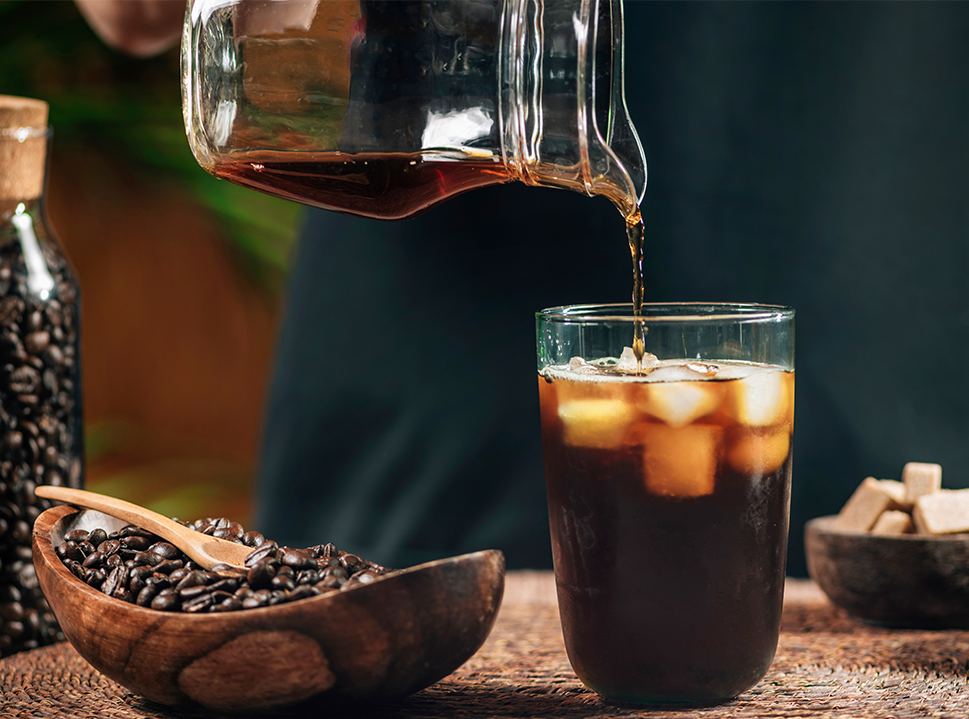
What Coffee Bean Is Best for Cold Brew?
Key Takeaways
- Cold brew is smoother and less acidic than hot coffee, making it easier on the stomach while still delivering bold flavour.
- Cold brew packs more caffeine per serving than espresso or drip coffee, thanks to its long steeping process and larger cup size
- Choosing the right coffee beans and grind size, ideally a medium or dark roast, coarsely ground, makes all the difference in creating a smooth, balanced cold brew at home.
If you love your coffee chilled, there’s nothing quite like a cold brew. Smooth, refreshing, and packed with flavour, cold brew coffee is perfect on a hot summer’s day, served alongside dessert, or simply enjoyed anytime you want a crisp caffeine hit.
But cold brew isn’t just iced coffee poured over ice. It’s a unique brewing method that extracts flavour differently, and the type of beans you choose plays a huge role in the taste.
What Is Cold Brew Coffee?
Cold brew is made by steeping coarsely ground coffee beans in cold or room-temperature water for an extended period, usually 15 to 24 hours. This slow extraction draws out natural oils and aromas, creating a concentrate that’s smooth, low in acidity, and naturally high in caffeine.
Compared to espresso or drip coffee, cold brew typically contains more caffeine per serving. Stored in the fridge, it keeps fresh for up to three days, making it an easy option for quick pours at home. For the best flavour, serve it over ice for a crisp, refreshing finish.
Science of Cold Brew and Acidity
Cold brew’s smooth flavour comes down to science. Because the coffee grounds are steeped in cold or room-temperature water rather than hot, fewer bitter compounds and acids are extracted. Research shows that cold brew can be up to 70 % less acidic than traditional drip coffee, making it gentler on the stomach while still retaining rich flavour notes. For people who struggle with digestive sensitivity or reflux, cold brew offers a way to enjoy coffee without the sharpness often found in hot brews
Another reason cold brew has gained popularity is its caffeine strength. While espresso is highly concentrated, a single shot contains about 63 mg of caffeine. By comparison, an 8-ounce serving of cold brew can deliver 100–200 mg, thanks to its long extraction time and larger serving size. This makes cold brew both stronger and smoother, an appealing combination for coffee drinkers seeking a refreshing yet powerful alternative to their daily espresso or filter coffee.
Key Factors When Making Cold Brew
If you want a balanced, flavourful cold brew, pay attention to these essentials:
Water Quality
Always use filtered water. It produces a cleaner, sweeter taste compared to tap water, allowing the natural flavours of the beans to shine through.
Grind Size
Cold brew works best with a coarse grind. The coffee grounds should feel gritty when rubbed between your fingers. If they’re too fine, the brew can turn out bitter and muddy.
Water Temperature
Skip the hot water, heat extracts acidity and bitterness. Stick to cold or room-temperature water for a smoother, less acidic result.
Steeping Time
Aim for 12–24 hours. Twelve hours works well for most, but if your grind is extra coarse, a longer steep brings out more flavour and body.
Choosing the Best Coffee Beans for Cold Brew
The roast you choose will shape your cold brew’s flavour profile.
- Dark Roast: Rich, earthy, and chocolatey. Produces a bold, classic flavour many cold brew lovers prefer.
- Medium Roast: Balanced and smooth with hints of caramel. A versatile option that works well if you enjoy a slightly lighter taste.
- Light Roast: Less common but still enjoyable. Brighter, fruitier notes that give your cold brew a unique twist.
For the best results, avoid instant coffee. Instead, go for freshly ground Arabica beans, they deliver a smooth, complex flavour with natural caramel and chocolate undertones. Pre-ground dark roasts or medium roasts are ideal if you want that robust, Italian-style cold brew taste.
How to Make Cold Brew Coffee at Home
Follow these simple steps to brew your own cold brew at home:
- Grind your beans coarsely.
- Add one tablespoon of ground coffee to a mesh bag or filter.
- Place the bag in a jug or container.
- Pour filtered water over the grounds.
- Cover and let it steep at room temperature for 12–24 hours.
- Remove the mesh bag and discard the grounds.
- Dilute the concentrate with cold water in a 1:1 ratio (adjust to taste).
- Serve over ice. Add syrups, milk, or sweetener if you prefer a sweeter cold brew.
Final Thoughts
Cold brew coffee is smoother, less acidic, and often stronger than regular coffee, making it a favourite for anyone who loves bold yet refreshing flavours. The secret lies in choosing the right beans, medium or dark roast Arabica beans are your best bet for a rich, full-bodied result.
At Primo Caffè, our premium blends are crafted to deliver the smooth, chocolate and caramel notes that shine in cold brew. Explore our great-value coffee beans and specialty products today, and enjoy café-quality cold brew from the comfort of your home.
Additional Reading
We're not done! Read some of our other content in our coffee Brewing blog, by following the links below.
- Different Types of Coffee
- How To Make Plunger Coffee
- How To Make Drip Coffee
- How Do You Make Ground Coffee
- What Is In a Macchiato Coffee
- How To Fix Sour Espresso
- Can Canned Coconut Milk Be Used in Coffee
- How To Make Black Coffee
- How To Use a Moka Pot
- How To Fix Under Extracted Coffee
- What Is Blooming Coffee
- Coffee Grind Size Guide
---
About the Author
Nicolas Di Stefano is a third-generation Master Roaster and Director of Primo Caffe. With decades of family tradition behind him, Nicolas combines time-honoured Italian roasting techniques with a passion for quality, delivering delicious coffee that Australians expect.

